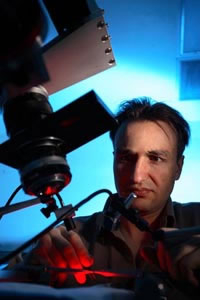Research Could Provide the Foundation for Creating Drugs and Treatments for Brain Injuries
A professor with the University of Houston Cullen College of Engineering is embarking on a research project that will show exactly how “plastic,” or adjustable, adult brains are.
Valery Kalatsky, assistant professor of electrical and computer engineering, works in the UH Center for Neuro-Engineering & Cognitive Science. Photo by Jeff Shaw.
Valery Kalatsky, assistant professor of electrical and computer engineering, is conducting research in collaboration with Hubert Dinse, a professor with Ruhr University in Bochum, Germany. Their work is supported by a three-year, $750,000 grant from the Human Frontiers Science Program, an organization dedicated to bringing together scientists with expertise in different fields and from different parts of the world.
Brain plasticity is at its peak in infancy, when brains are most capable of adjustment. Babies who suffer significant brain trauma, for example, will often make near-complete recoveries. This is because their brains are in the process of organizing themselves and are able to assign tasks normally performed by the damaged areas to the still-functioning portions.
Because adult brains are already organized, they have much less plasticity and make only very small adjustments when damaged. Kalatsky and Dinse intend to determine the plasticity level of the adult brain—the degree of which is currently unknown.
Though others have performed research into adult brain plasticity, this project distinguishes itself by how much and what kind of data it will collect.
To study plasticity, researchers use various techniques and tools to produce maps that outline exactly what sections of the brain control what functions. For example, when studying the visual cortex, which controls sight, an orientation map tells researchers what sections of the cortex prefer objects oriented to specific angles, such as horizontally aligned objects, vertically aligned objects, etc.
Using standard tools, it takes scientists hours to create a single orientation map. They then stimulate an area of the brain, causing it to reorganize, and create additional orientation maps, which again takes hours. As a result, these researchers usually are able to acquire only a few maps that show the cortex’s functional structure before and after reorganization.
Kalatsky and Dinse’s approach will provide a much more comprehensive picture of adult brain plasticity. This will be achieved through the use of an optical imaging device being developed by Kalatsky that creates orientation maps 30-times faster than standard methods.
With this device, Kalatsky and Dinse will take an initial reading of the visual cortex. A small section of the visual cortex will then be directly stimulated, resulting in that section and the surrounding areas reorganizing themselves. The imaging device, because of its speed, will create orientation maps every few minutes during reorganization, providing a much more dynamic understanding of brain plasticity.
“With this approach,” said Kalatsky, “we’ll be able to see the reorganization as it happens.”
These maps will help scientists determine how much recovery from brain injury is possible without the assistance of medication. It will also, Kalatsky added, give scientists the foundation to conduct research into not just the plasticity of the adult brain, but also how that plasticity can be manipulated.
This future research may yield new medicines and treatments that could help repair brain damage, Kalatsky said. “First you have to understand the baseline. Then when you figure it out you can ask what kind of drugs or therapies will arrest or unleash plasticity.”
